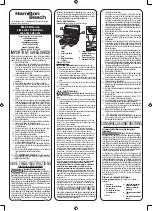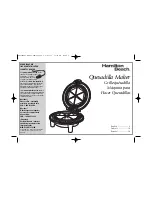
en
Avoiding material damage
16
WARNING ‒ Risk of fire!
The heat-sealing bar in the vacuum-sealing
compartment becomes extremely hot. Com-
bustible vapours may ignite.
▶
Do not vacuum-seal any combustible li-
quids in the vacuum-sealing bag.
▶
Do not store any combustible materials and
objects inside the appliance.
WARNING ‒ Risk of injury!
The smallest cracks in the glass lid may result
in it imploding when the vacuum is attached.
▶
Unplug the appliance from the mains or
switch off the circuit breaker in the fuse
box.
▶
Call after-sales service.
Any misuse of the vacuum-sealing drawer
may lead to injury.
▶
Do not insert any hoses that are connected
to the appliance into any body cavities.
▶
Do not vacuum-seal any living animals.
WARNING ‒ Risk of harm to health!
During the vacuuming process, the vacuum-
sealing compartment and the glass lid de-
form. The protective layer on the glass may
be damaged and the glass lid may break.
▶
Screw-top jars, other hard containers, and
non-deformable food that are vacuum-
sealed in the compartment when the lid is
closed must not come into contact with this
lid.
▶
Hard containers and non-deformable food
must not protrude over a maximum height
of 80 mm.
WARNING ‒ Risk of suffocation!
Children may put packaging material over
their heads or wrap themselves up in it and
suffocate.
▶
Keep packaging material away from chil-
dren.
▶
Do not let children play with packaging ma-
terial.
Children may breathe in or swallow small
parts, causing them to suffocate.
▶
Keep small parts away from children.
▶
Do not let children play with small parts.
2 Avoiding material damage
ATTENTION!
Damage to the appliance may affect the safety consid-
erably.
▶
Check the appliance for damage before each use.
▶
Check that the glass lid is intact.
▶
Never use a damaged appliance.
▶
Call after-sales service.
Using the appliance carelessly may cause damage to
the appliance.
▶
Open and close the glass lid slowly.
▶
Do not place any objects on the glass lid.
▶
Do not use the appliance as a work surface or stor-
age space.
▶
Do not let any objects fall onto the glass lid.
▶
Pull the drawer out completely during use.
▶
After use, close the drawer completely.
Foreign objects in the vacuum-sealing compartment
damage the appliance.
▶
Before closing the glass lid, ensure that there is no
debris in the vacuum-sealing compartment.
If the seal is sitting incorrectly or is damaged, this im-
pairs the function of the appliance and may damage
the appliance.
▶
Check that the seal is positioned correctly on the
glass lid.
▶
The seal's contact surface must be clean and free
from debris.
▶
Do not damage the seal with pointed or sharp ob-
jects.
▶
Never operate an appliance with a defective seal.
▶
If a seal is defective, contact after-sales service.
Using tools to open the glass lid damages the appli-
ance.
▶
In the event of a power cut during the vacuum-seal-
ing process, wait until the power supply is restored.
The vacuum in the vacuum-sealing compartment is
retained. Restart the vacuum-sealing process.
Escaping steam caused by boiling at excessive tem-
peratures may lead to malfunctions.
▶
Only use bags that are suitable for vacuum-sealing
food.
▶
Do not use any sales packages that have already
been opened.
▶
Process the food that is to be vacuum-sealed at an
output temperature of 1–8 °C.
▶
Do not vacuum-seal liquids in the vacuum-sealing
bag at the highest level. Use vacuum-sealing
level 2.
▶
Heat-seal the bag if you notice an intensified forma-
tion of bubbles.
Содержание DVP 221
Страница 27: ......













































